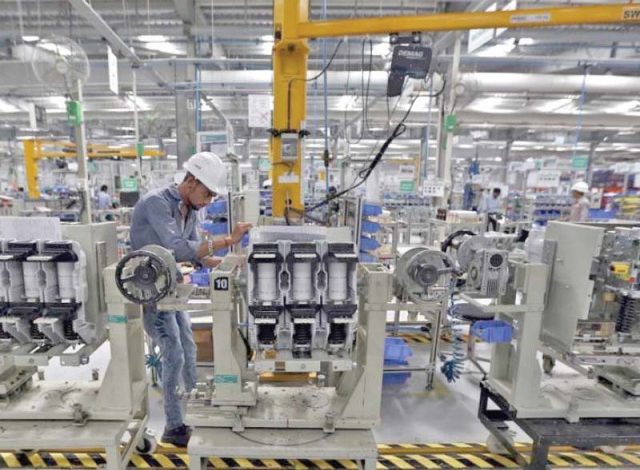The government surprises with a growth of 5.7%.

On the strength of a 20% rise in industrial sector output—which everyone feels is suffering greatly due to tight economic conditions—the administration approved a 5.7% economic growth rate for the final quarter of the previous fiscal year on Wednesday.
The unexpected findings imply that, even with double-digit interest rates, strict fiscal and monetary policies, and higher taxes and energy tariffs than regional nations, Pakistan’s economy can nevertheless develop by 6% without addressing fundamental structural flaws.
The National Accounts Committee (NAC) confirmed the growth estimates on Wednesday, but they also included significant modifications to the quarterly numbers and several unusual anomalies. The NAC meeting was presided over by Secretary of Planning Awais Manzur Sumra.
According to data issued by the Pakistan Bureau of Statistics (PBS) during the NAC meeting, the NAC approved a 5.7% growth rate for the April-June quarter, compared to just 2.8% increase in the previous quarter.
Two days after it was revealed that the PBS had underreported imports for the previous two fiscal years by $11 billion because the Pakistan Revenue Automation Limited had failed to log certain imports, the NAC meeting was conducted.
The annual economic growth for fiscal year 2024–2025 was similarly boosted by the abrupt economic recovery, rising from 2.7% to little over 3%.
According to sources, several NAC members brought attention to discrepancies in the production of the building industry and related sectors. According to the sources, they also brought attention to problems with the rise in electricity, the odd rise in minor crop production, and discrepancies in the quarterly growth statistics.
In the fourth quarter of FY25, the industrial sector reported a’remarkable’ rise of 20%, as per the provisional statistics, while the previous quarter had nominal growth of 1.2%. The economic growth for the quarter increased to 5.7% as a result.
In contrast to a 4% decline in the preceding three months, the NAC authorized a 121.4% rise in the electricity, gas, and water supply sectors during the April–June quarter.
The government has long lamented the sharp decline in domestic electricity demand brought on by high prices, and the industrial sector was compelled to join the national grid for the same reason.
According to the PBS, a “higher subsidy as compared to the fourth quarter of last year as well as the effect of deflator” was the cause of the 121.4% increase in power generation.
In contrast to the previous quarter’s 10.7% growth, the NAC authorized a 17.7% expansion in the construction sector in the fourth quarter. The government’s tax policies, rising interest rates, and the general recession in the economy have all had a negative impact on the construction industry.
The idea that Pakistan’s economy is failing due to a weak structure is refuted by the fourth quarter data. If the numbers are accurate, they indicate that Pakistan can expand at a pace of 6% in spite of the IMF’s plans for fiscal austerity.
According to details, the mining and quarrying sector reported a 1.94% increase in the fourth quarter, while the previous quarter saw a 2.9% contraction “due to increase in production of limestone and marble.”
Similarly, according to the NAC working paper, large-scale manufacturing, which had been steadily declining throughout the first three quarters of FY25, unexpectedly increased by 3% in the final quarter.
Revision every year
Following the release of comprehensive data, the PBS announced that the annual economic growth for fiscal year 2024–2025 was being revised upward to 3.04%. The government had earlier in June announced a 2.7% growth, which the independent economists had viewed with skepticism. They had calculated that in order to reach the 2.7% rate, a 5.7% growth would be needed.
For the most recent fiscal year, the NAC increased the agriculture sector’s growth rate from 0.56% to 1.5%. The services sector was projected to develop at a rate of 3%, while the industrial sector’s growth was revised from 4.8% to 5.3%.
sector of agriculture
According to the PBS, the contraction in key crops was somewhat smaller than what was recorded in June. However, a sharp increase in minor crops—whose initial 4.8% growth was changed to 19.6%—was the cause of the agriculture sector’s reported 1.51% rise. It is among the most pronounced upward revisions.
In the previous fiscal year, the “positive output in green fodder” increased by 16%, which was the official explanation for the growth in minor crops. However, according to the PBS, the rise in intermediate consumption of green fodder caused livestock growth to drop from 4.7% to 2.94%.
Sector
Significant upward modifications in the industrial sector were also allowed by the government. It decreased the mining and quarrying sector’s shrinkage from 3.4%, as reported in June, to 2.4%. The industry that supplies gas, electricity, and water was found to be expanding at 28.53% annually.
How it was accomplished
Additionally, the NAC authorized changes to the first three quarters’ economic growth figures. The NAC raised the growth to 1.8% from the 1.4% previously allowed for the first quarter. Similar revisions were made to the second quarter growth, which went from 1.53% to 1.94%, and the third quarter growth, which went from 2.4% to 2.8%.
The agriculture sector’s growth was changed from 0.8% to 1.6% and from 0.8% to 2% for the second quarter. The third quarter saw a significant change, with growth rising from 1.2% to 2.4%. According to the PBS, the quarterly projections for each of the four quarters are modified once the annual statistics are available.
Taboola-sponsored links on Facebook, Twitter, Whatsapp, and email
You might enjoy
Read on for tips and tricks on how your finger shape might reveal a lot about your personality.